American Bonsai at the NC Arboretum
+95
kingsnake
Tom
MKBonsai
BrianS
manumidam
Chris Cochrane
Intricate Simplicity
chench53
KyleT
Maros Belan
DjTommy
Bolero
Gonetopot
Rick36
M. Frary
Van
Toshiro
fiona
Precarious
drbuzzbee
geo
LanceMac10
MichaelS
kimo
Chellis
Leo Schordje
FrankP999
dick benbow
BrianG
crust
TN Jim
Seth Ellwood
Wander
peterkang
Judgie
Kevin S - Wisco Bonsai
Vance Wood
JMcCoy
brett2013
GerhardGerber
lordy
Eric Group
my nellie
steveb
Jaybird
Todd Ellis
jgeanangel
Daygan
AlainK
Richard S
Randy_Davis
Robert J. Baran
David Brunner
William N. Valavanis
Jkd2572
Dale Cochoy
Jesse McMahon
prestontolbert
yamasuri
bingregory
Stephen Krall
DougB
Ashiod
JADunnagan
sayotefries
JudyB
Dan W.
Khaimraj Seepersad
DuncanJH
Dave Murphy
monte
MikeG
augustine
Russell Coker
Kev Bailey
lennard
BigDave
Marty Weiser
Smithy
coh
tmmason10
dorothy7774
gman
Dave Leppo
hometeamrocker
bwaynef
Billy M. Rhodes
Walter Pall
Sam Ogranaja
JimLewis
MartinSweeney
bonsaisr
Auballagh
John Quinn
Arthur Joura
99 posters
Page 17 of 40
Page 17 of 40 •  1 ... 10 ... 16, 17, 18 ... 28 ... 40
1 ... 10 ... 16, 17, 18 ... 28 ... 40 
 Re: American Bonsai at the NC Arboretum
Re: American Bonsai at the NC Arboretum
Hi Arthur,
I had missed this follow-up but I just wanted to tell you it's always a pleasure to read you and see your work: this tree's beautiful and it's in good hands
I had missed this follow-up but I just wanted to tell you it's always a pleasure to read you and see your work: this tree's beautiful and it's in good hands

AlainK- Member
 Re: American Bonsai at the NC Arboretum
Re: American Bonsai at the NC Arboretum
AlainK wrote:Hi Arthur,
I had missed this follow-up but I just wanted to tell you it's always a pleasure to read you and see your work: this tree's beautiful and it's in good hands
yes true
kimo- Member
 Re: American Bonsai at the NC Arboretum
Re: American Bonsai at the NC Arboretum
Hi Arthur,
I hope all is well, and you're just busy working on miniature trees. I've been keeping an eye out for new posts, and patiently/eagerly waiting for the next one.
I hope all is well, and you're just busy working on miniature trees. I've been keeping an eye out for new posts, and patiently/eagerly waiting for the next one.

Dan W.- Member
 Re: American Bonsai at the NC Arboretum
Re: American Bonsai at the NC Arboretum
Love the "chinese" design approach of the last tree.
kimo- Member
 Thoughts on Dan Robinson, part 1
Thoughts on Dan Robinson, part 1
I did not used to mind flying. I still do not mind the actual being up in the air part of it, but everything else that goes with it now - having to show up early for the TSA inspection, enduring the impersonal plastic sterility of the airport, being packed in the plane like chickens heading for the processing plant, the need to pay extra for any little comfort or service or anything that might make the whole experience something less than a misery - all that stuff I do not enjoy. The trip I was making to Washington state required a longer time dealing with planes and airports than I had done in awhile, and either I had forgotten how bad it is or it has gotten worse since the last time I flew, but I was badly agitated by the time I landed in Seattle. It did not help that I had been awake for more than 20 hours. I was fried.
Dan Robinson met me when I landed and we were soon packed into his vehicle and heading for his place, an hour or so drive from the airport. We talked easily despite the fact we had not seen or spoken to each other in more than 9 years. When we finally pulled up his driveway the location seemed remote and was surrounded by big trees, more or less what I would have expected for a place Dan would call home, and it was 1 AM in the deep woods dark. Now I was dead-tired as we stumbled through the night to the door of the house, and I could not see what the house looked like but that it seemed of unusual construction, and Dan got out his key and opened the door. He stepped in and I followed. My head was lowered, making sure of my step in the dark through the unfamiliar threshold, and Dan said "say hello to Charlie..." I was expecting a dog or a cat and I looked up. I found myself nose to nose with a black bear. We have bears pass through our yard at home from time to time, raiding the garbage cans and the bird feeder, so I have a slightly higher consciousness of them and I know one situation you want to avoid with a black bear is finding yourself nose to nose with it. I jumped in shock. By the time I came back down I realized the bear was not moving, was not capable of moving. It was stuffed. It was posed in the sitting position and it was in pristine condition, taxidermied with great skill, the small shiny eyes glinting with secret life. I expected them to blink. Dan looked at me with satisfied amusement. It was the end of a long ragged day, and an appropriate start to an extended weekend visit with one of the true rugged individualists you might ever hope to meet in bonsai, or just about any other walk of life.

Dan Robinson met me when I landed and we were soon packed into his vehicle and heading for his place, an hour or so drive from the airport. We talked easily despite the fact we had not seen or spoken to each other in more than 9 years. When we finally pulled up his driveway the location seemed remote and was surrounded by big trees, more or less what I would have expected for a place Dan would call home, and it was 1 AM in the deep woods dark. Now I was dead-tired as we stumbled through the night to the door of the house, and I could not see what the house looked like but that it seemed of unusual construction, and Dan got out his key and opened the door. He stepped in and I followed. My head was lowered, making sure of my step in the dark through the unfamiliar threshold, and Dan said "say hello to Charlie..." I was expecting a dog or a cat and I looked up. I found myself nose to nose with a black bear. We have bears pass through our yard at home from time to time, raiding the garbage cans and the bird feeder, so I have a slightly higher consciousness of them and I know one situation you want to avoid with a black bear is finding yourself nose to nose with it. I jumped in shock. By the time I came back down I realized the bear was not moving, was not capable of moving. It was stuffed. It was posed in the sitting position and it was in pristine condition, taxidermied with great skill, the small shiny eyes glinting with secret life. I expected them to blink. Dan looked at me with satisfied amusement. It was the end of a long ragged day, and an appropriate start to an extended weekend visit with one of the true rugged individualists you might ever hope to meet in bonsai, or just about any other walk of life.

Last edited by Arthur Joura on Tue Aug 11, 2015 10:25 pm; edited 1 time in total
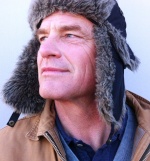
Arthur Joura- Member
 Thoughts on Dan Robinson, part 2
Thoughts on Dan Robinson, part 2
Dan Robinson has been in bonsai for a long time now, something on the order of 50 years or more, and for the great majority of that time he has been a figure of national and eventually international reputation. There is a book about Dan, "Gnarly Branches, Ancient Trees ", that does a fine job of recounting his colorful life. For a bonsai book it is quite good and filled with quality photographs of some of Dan's best trees, so those who want to learn more about his life and work should seek out that book. There is no need then for me to try in this small article to recount his personal story in any sort of detail. My purpose instead is to report what happened on my recent visit to Washington and the time I spent there in Dan's company, but I cannot do that without touching at least a little on who he is. Dan has led an adventuresome life and he is a robust person with a keen mind who has achieved much in his chosen field, but he is also a lightning rod of sorts. He has upset a lot of bonsai people over the years, not necessarily on purpose, but I do not think he particularly cares so much when it happens. The problem with Dan is that he is his own man. He is adamantly, stubbornly, un-appologetically individualistic in his thinking and in his work, and his vision of bonsai falls outside of the mainstream in a good many ways. On the whole it seems people in bonsai are rather conservative in their thinking. That is, they view bonsai as being more or less set in place, completely established, and not particularly in need of being re-thought or reinvented, just learned and practiced humbly. In this frame of thinking an individualistic take on bonsai falls outside the accepted parameters, is misguided at least, and may even be seen as wrong in a threatening way. No wonder Dan Robinson has made some waves! If the traditionalist bonsai lovers might be said to view bonsai as being in the company of the Tea Ceremony as a sort of quietly refined ritualistic exercise, Dan can be viewed as a wild man from the woods, coming to the party dressed in animal skins and tracking mud on the tatami mats, whooping and hollering with energetic exuberance.
Yet he has enjoyed success in bonsai. He has headlined numerous conventions and symposiums in the US, sometimes causing controversy, and traveled as a presenter and educator in Europe and the Philippines. He has followers, people who look up to him as a teacher. He has a major tree in the US National Collection, and he designed, built and operates a unique public bonsai museum featuring his own extensive personal collection, as part of the Elandan Gardens enterprise he owns with his wife Diane. It was there at Elandan I first met Dan on a trip to the Northwest I made in 2001. My visit then was in preparation for the design work we were doing at the NC Arboretum, as we began the process that would ultimately lead to our Bonsai Exhibition Garden. I was traveling around to see other public bonsai collections, to see what they looked like and to steal any good ideas I might come across, and the real object of interest for me in the Seattle area was the Pacific Rim Bonsai Collection, as it was then called, on the Weyerhauser campus in Federal Way. Having gone there and seen that and having been duly impressed with the place, I then went to Elandan only as a secondary destination. I had not set up any appointment, but showed up unannounced and began to nose around. Dan Robinson happened to be in that day and I soon ran into him. I introduced myself, explaining where I was from and what I was about and right away Dan started showing me around, giving me the VIP tour. I thought it was a VIP tour anyway, but later learned that he is likely to do that with anyone who shows up. He is generous with his time and loves to talk bonsai with anyone who is interested. After the staid and formal feeling of the Pacific Rim display, the loose and eclectic look of Elandan was almost jarring. I recognized immediately I was looking at a labor of love, the product of one person's individualistic vision, a completely different take on bonsai display than I had ever seen before. The look of it appealed to me on some level, but I did not take it seriously.
I did not take it seriously. I had a well established idea of what a proper bonsai display looked like, and it looked like the one they had at the National Arboretum or the one I had seen the day before at the Weyerhauser campus, benches with bonsai lined up on them, a blank wall running behind them, tasteful, restrained. Dan's place was a colorful jumble of surprises, lush, even gaudy in places, with the hulking husks of large dead trees jutting up here and there and huge boulders scattered about and all right on the shores of Puget Sound. It was disorientingly different. I enjoyed it, but I was pretty certain bonsai were not meant to be displayed in that kind of setting. I had never seen them displayed so, anyway. Then again I had never seen bonsai look like those I was now seeing at Elandan.



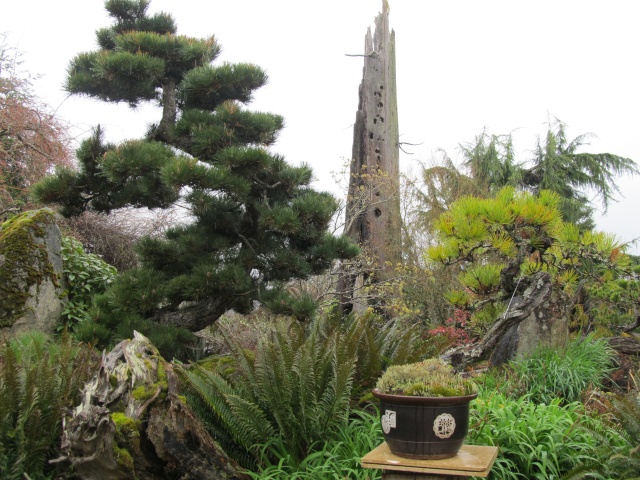
I have no difficulty remembering what I thought of Dan Robinson's trees the first time I encountered them, in fact I remember exactly. They were old and gnarly and full of character, they looked untamed and I thought to myself "I would like to work on these trees!" Meaning, I would like to make these wild things look like bonsai. I cringe now at that, the presumptuousness of it and how much I did not understand what I was looking at, but I am being honest about it. I confessed this to Dan on this most recent visit, and apologized for it too. Dan smiled and shrugged it off. He has heard these kind of things many times before, such uncomprehending opinions, or worse - rude and ignorant insults. I have heard them too, about Dan's work. One person told me Dan's trees are not bonsai, but pre-bonsai. It is tough to be so far out in front of the pack, doing things other people have not thought of yet or may never think of and never understand.
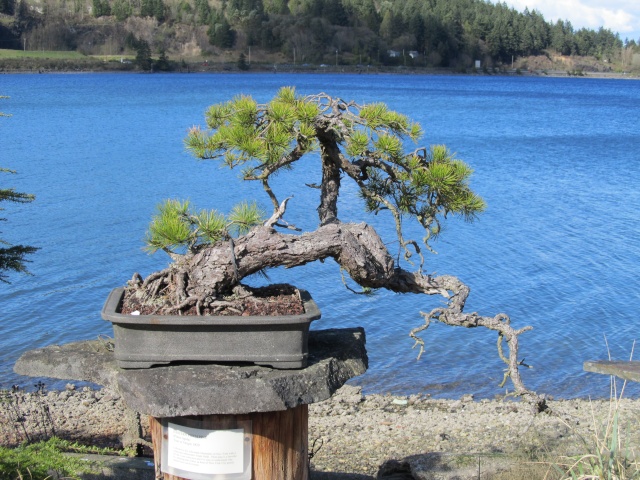
Yet he has enjoyed success in bonsai. He has headlined numerous conventions and symposiums in the US, sometimes causing controversy, and traveled as a presenter and educator in Europe and the Philippines. He has followers, people who look up to him as a teacher. He has a major tree in the US National Collection, and he designed, built and operates a unique public bonsai museum featuring his own extensive personal collection, as part of the Elandan Gardens enterprise he owns with his wife Diane. It was there at Elandan I first met Dan on a trip to the Northwest I made in 2001. My visit then was in preparation for the design work we were doing at the NC Arboretum, as we began the process that would ultimately lead to our Bonsai Exhibition Garden. I was traveling around to see other public bonsai collections, to see what they looked like and to steal any good ideas I might come across, and the real object of interest for me in the Seattle area was the Pacific Rim Bonsai Collection, as it was then called, on the Weyerhauser campus in Federal Way. Having gone there and seen that and having been duly impressed with the place, I then went to Elandan only as a secondary destination. I had not set up any appointment, but showed up unannounced and began to nose around. Dan Robinson happened to be in that day and I soon ran into him. I introduced myself, explaining where I was from and what I was about and right away Dan started showing me around, giving me the VIP tour. I thought it was a VIP tour anyway, but later learned that he is likely to do that with anyone who shows up. He is generous with his time and loves to talk bonsai with anyone who is interested. After the staid and formal feeling of the Pacific Rim display, the loose and eclectic look of Elandan was almost jarring. I recognized immediately I was looking at a labor of love, the product of one person's individualistic vision, a completely different take on bonsai display than I had ever seen before. The look of it appealed to me on some level, but I did not take it seriously.
I did not take it seriously. I had a well established idea of what a proper bonsai display looked like, and it looked like the one they had at the National Arboretum or the one I had seen the day before at the Weyerhauser campus, benches with bonsai lined up on them, a blank wall running behind them, tasteful, restrained. Dan's place was a colorful jumble of surprises, lush, even gaudy in places, with the hulking husks of large dead trees jutting up here and there and huge boulders scattered about and all right on the shores of Puget Sound. It was disorientingly different. I enjoyed it, but I was pretty certain bonsai were not meant to be displayed in that kind of setting. I had never seen them displayed so, anyway. Then again I had never seen bonsai look like those I was now seeing at Elandan.




I have no difficulty remembering what I thought of Dan Robinson's trees the first time I encountered them, in fact I remember exactly. They were old and gnarly and full of character, they looked untamed and I thought to myself "I would like to work on these trees!" Meaning, I would like to make these wild things look like bonsai. I cringe now at that, the presumptuousness of it and how much I did not understand what I was looking at, but I am being honest about it. I confessed this to Dan on this most recent visit, and apologized for it too. Dan smiled and shrugged it off. He has heard these kind of things many times before, such uncomprehending opinions, or worse - rude and ignorant insults. I have heard them too, about Dan's work. One person told me Dan's trees are not bonsai, but pre-bonsai. It is tough to be so far out in front of the pack, doing things other people have not thought of yet or may never think of and never understand.

Last edited by Arthur Joura on Tue Aug 11, 2015 10:28 pm; edited 2 times in total

Arthur Joura- Member
 Re: American Bonsai at the NC Arboretum
Re: American Bonsai at the NC Arboretum
Thanks, Arthur...
An interesting note (I have the book mentioned): Elandan gardens is built completely over reclaimed land that was a Dump!
An interesting note (I have the book mentioned): Elandan gardens is built completely over reclaimed land that was a Dump!
Dave Leppo- Member
 Re: American Bonsai at the NC Arboretum
Re: American Bonsai at the NC Arboretum
Dave Leppo wrote:Thanks, Arthur...
An interesting note (I have the book mentioned): Elandan gardens is built completely over reclaimed land that was a Dump!
They may be becoming scarce. For those who may want to order, here's the Author's latest plug for his book:
http://bonsainut.com/index.php?threads/how-to-order-gnarly-branches-ancient-trees-while-you-still-can.17881/#post-248821

JimLewis- Member
 Re: American Bonsai at the NC Arboretum
Re: American Bonsai at the NC Arboretum
Thanks Arthur. It is very difficult to break away from the "Japanese" mold. Most judges in the US see tree through the traditional Japanese filter. Perhaps someday all trees will be judges (hence other follow and copy their beauty) for their own unique natural and artistic beauty. Enjoy the natural beauty of fall in the mountains.

DougB- Member
 Re: American Bonsai at the NC Arboretum
Re: American Bonsai at the NC Arboretum
HE'S BACK !!! 
hey Arthur... glad you had the time to visit the forum again during what i know to be a busy time for you with the 20th anniversary expo coming up in about 60 days.
i am especially grateful for introducing me to this Dan Robinson that you write of...
from your description he seems like the type of artist i will be looking into along the other non-traditionalists that i admire.
i dig the feel of his garden from the few pics you posted and would love to see more...
thanks again and see you in a couple months !
hey Arthur... glad you had the time to visit the forum again during what i know to be a busy time for you with the 20th anniversary expo coming up in about 60 days.
i am especially grateful for introducing me to this Dan Robinson that you write of...
from your description he seems like the type of artist i will be looking into along the other non-traditionalists that i admire.
i dig the feel of his garden from the few pics you posted and would love to see more...
thanks again and see you in a couple months !

Kevin S - Wisco Bonsai- Member
 Re: American Bonsai at the NC Arboretum
Re: American Bonsai at the NC Arboretum
JimLewis wrote:Dave Leppo wrote:Thanks, Arthur...
An interesting note (I have the book mentioned): Elandan gardens is built completely over reclaimed land that was a Dump!
They may be becoming scarce. For those who may want to order, here's the Author's latest plug for his book:
http://bonsainut.com/index.php?threads/how-to-order-gnarly-branches-ancient-trees-while-you-still-can.17881/#post-248821
arthur's link in part 2 of his post takes you directly to their site and i just got off the phone to verify they still have some...
they do...
...and so will i when it gets here.

Kevin S - Wisco Bonsai- Member
 Re: American Bonsai at the NC Arboretum
Re: American Bonsai at the NC Arboretum
Glad to see you posting in this thread again, a very welcome sight.
I too have had the Dan Robinson experience, I am lucky enough to be friends with Will Hiltz (author of the book on Dan) through another forum. When we were out that way a few years ago, we met Will and Dan at Elandan and spent most of the afternoon wandering the glorious pathways of that amazing place, all the while soaking up the stories, and character that Dan exudes. It was something I'll never forget, and the trees are so particularly of a kind. Authentic I would call them. He is a tree guy, not a bonsai guy, and he'd be the first to agree with that I believe. He is generous with his time and a gracious host. I would say that this should be one of those life list places to see if you can possibly do it.
Oh, and BTW the book is wonderful, and a great way to see the trees in a way that shows them in a uncluttered setting, so you can see the trees fully.
I too have had the Dan Robinson experience, I am lucky enough to be friends with Will Hiltz (author of the book on Dan) through another forum. When we were out that way a few years ago, we met Will and Dan at Elandan and spent most of the afternoon wandering the glorious pathways of that amazing place, all the while soaking up the stories, and character that Dan exudes. It was something I'll never forget, and the trees are so particularly of a kind. Authentic I would call them. He is a tree guy, not a bonsai guy, and he'd be the first to agree with that I believe. He is generous with his time and a gracious host. I would say that this should be one of those life list places to see if you can possibly do it.
Oh, and BTW the book is wonderful, and a great way to see the trees in a way that shows them in a uncluttered setting, so you can see the trees fully.
JudyB- Member
 Thoughts on Dan Robinson, part 3
Thoughts on Dan Robinson, part 3
These recollections of the first visit were in my mind when I made my return this year. In the 14 years between then and now my ideas about bonsai have evolved, and now I was eager to see Dan's trees again and see Elandan again, to stand before them in person and look with new eyes. This time I went expressly to see them. I say that, but it is not quite right. I was invited to Seattle to present a program to the Puget Sound Bonsai Association and that was my ticket for traveling all the way across the country, but I do not know that I would have been able to justify taking the time off from work in March, the start of the growing season, and going all that way just to do a single program. I was glad to pack up my act and take it on the road to some place I had never presented before but the real lure was the return to Elandan, and the chance to look again at Dan Robinson's work. To see his garden and trees but also to talk with him in hopes of learning something, instead of starting with the assumption that somehow I know more about bonsai than he does.
After being greeted by the bear there in the dark in the early hours of the morning, I crawled off to bed. A few minutes later, or so it seemed, there is daylight streaming through the window and there is a bang on the door and it flies open and there is Dan, dressed and ready for the new day. In a booming voice he calls out "You going to sleep all day?" Apparently not! Soon I am up and around and have a chance to see where I am, all that was hidden in the dark when I first arrived. It seems I had been sleeping in a museum. Dan and Diane's home is unlike any other I had ever seen. It is a storehouse of curious and exotic items, some of them rare antiques from the other side of the world, beautiful artwork, stuffed animals and trophy mounts (purchased at auctions and estate sales, none of them killed by Dan or Diane), live animals, large tropical plants and big boulders. Big boulders, in the house. The house must have been built around them because they are too big to have been brought in the door. Dan built the house, not all by himself but he had an active hand in the design and construction, so there is no wonder it is an original one-of-a-kind place. Step outside the house and you see that it is built alongside a beautiful lake, surrounded by tall Western Redcedars. Or maybe you might not notice them right away because your attention is grabbed by all the bonsai, dozens of them, maybe hundreds and all unique in their look. Many of them are collected trees by the looks of them, but others are younger looking and there are even some tropicals, which surprises you. These specimens are scattered all about the place here and there and then you notice the landscaping, the boulders, the trees growing in the ground but shaped and sculpted like bonsai. You realize then you are looking at another Dan Robinson landscape, like Elandan, and like the others he has built for people who hire him to create these little pieces of wonderland around their homes, and seeing this and the house too you become aware that Dan is a creative force. He works with nature and reshapes it to express his idealized vision of the natural world.
After a good look around his homestead Dan and I get in his truck and he proceeds to conduct a tour of several big, old growth trees in the area a few miles around where he lives. These are trees that were once part of the great Pacific Northwest forest, which has been largely cleared for profit and converted to tree farms or to make way for human habitation, or tamed for purposes of human enterprise, and these few trees somehow survived the great reshaping of the land. Dan knows where they are. He has known these trees for many years because he has lived here for a long time, and he has sought them out and has come to regard them as old friends. At each place we stop to observe these ancient giants Dan expounds on the features they display and the forces of nature that shaped them. You hear him talk and you know he is someone who has spent years and years out in the field, observing and thinking. He knows many facts and has many theories about how trees grow, and sometimes it is difficult to know where fact leaves off and theory begins but every bit of it is backed up by first-hand experience in the field, out among the trees. He also talks about how this knowledge of the ways of ancient trees informs the way he designs his bonsai, and this is of particular interest to me. I am doing this now, taking my own experience of trees as I know them and integrating it into my bonsai work. It is more difficult to do than you might think. To begin with you must put in the time out among the trees in nature, observing them critically and actively working to understand them, the way they grow differently one to the next, what shapes them and why. I allow myself to think I know more about this stuff than most people in bonsai, but Dan knows more about it than I do, at least as regards the great old trees in his neck of the woods. He is a lover of trees and I identify with him that way.
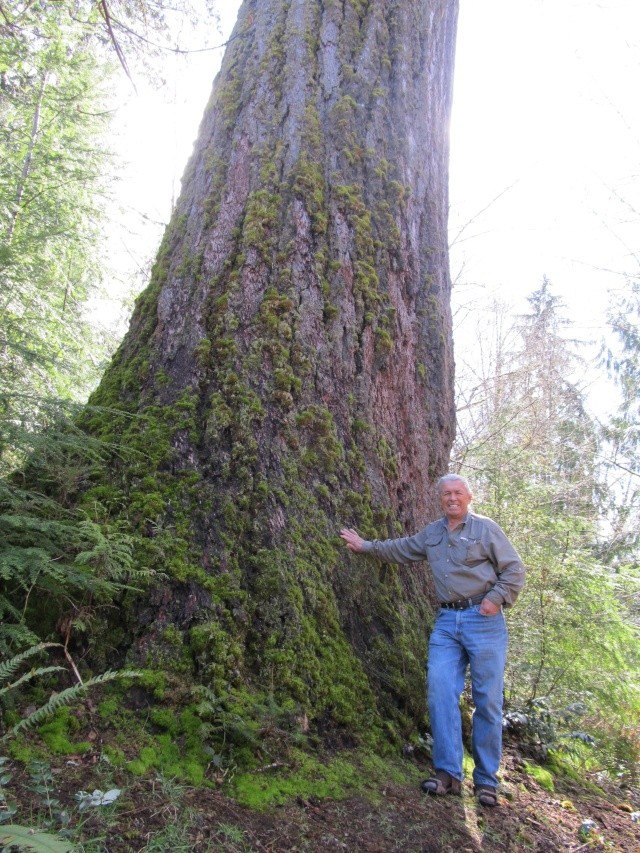



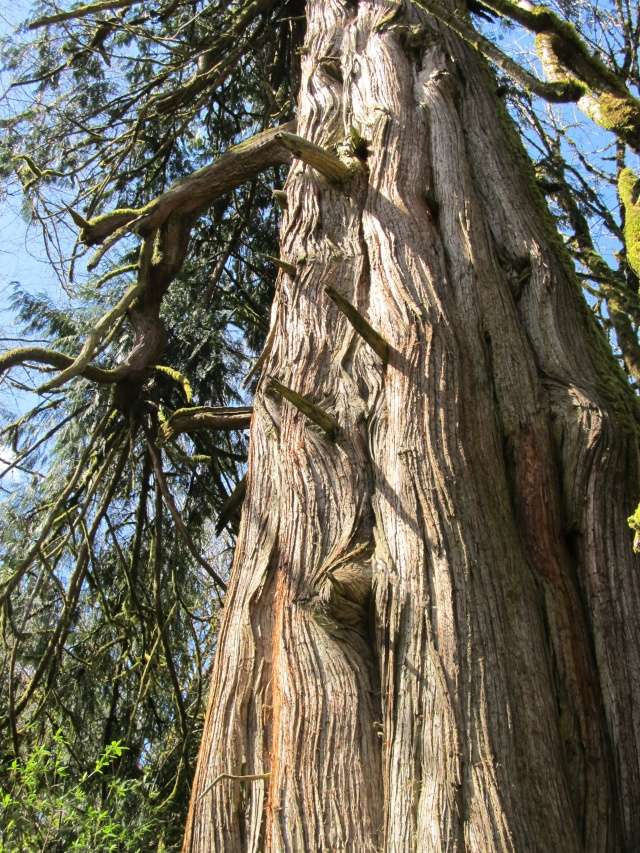
By and by we make our way to Elandan and Dan leaves me there to fend for myself awhile as he heads off on a pruning job. The tree that is to be shaped is a full sized canopy tree in someone's yard and he will be directing the work from the ground, as he no longer climbs up and does the saw work himself. Dan used to climb the big ones but he recently decided to give it up, a grudging nod to the fact that he is now 75 years old. At Elandan I spend a little time catching up with Diane Robinson, who is taking care of business behind the counter at the gift shop and gallery she runs there. This store is filled with wondrous bits of this and that from all over the world, the same kind of things I saw displayed all over the Robinson house earlier that day. A person might spend hours exploring it all, but I do not, not today. My interest is in the bonsai and those are outside in the open air museum. I step outside and take it in. It is as I remember it, but now 14 years later the landscape is more mature, filled in, settled and comfortable. When I was there in '01 it was all still fairly new and a little raw. This is the natural progression with gardens. It takes them awhile to come into their own. I begin to wander around and everywhere you look there is something of interest to see - whether it be fantastic displays of rock work with delicate alpine plants growing in crevices, or sculpted rock (done by Dan's son, Will), or sculpted landscape trees, or those statuesque old snag tree corpses jutting up toward the sky, or some bit of beautiful borrowed scenery of the Pacific Northwest, like the waters of Puget Sound or a bald eagle flying overhead. And throughout this magical landscape, informally distributed on a stand here or a rock there, are the bonsai.
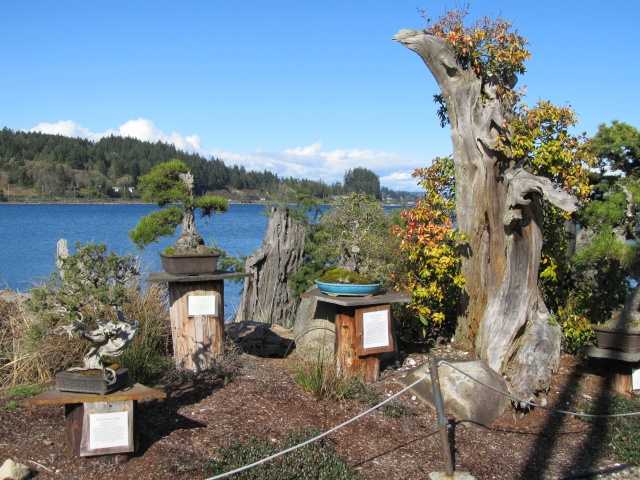

After being greeted by the bear there in the dark in the early hours of the morning, I crawled off to bed. A few minutes later, or so it seemed, there is daylight streaming through the window and there is a bang on the door and it flies open and there is Dan, dressed and ready for the new day. In a booming voice he calls out "You going to sleep all day?" Apparently not! Soon I am up and around and have a chance to see where I am, all that was hidden in the dark when I first arrived. It seems I had been sleeping in a museum. Dan and Diane's home is unlike any other I had ever seen. It is a storehouse of curious and exotic items, some of them rare antiques from the other side of the world, beautiful artwork, stuffed animals and trophy mounts (purchased at auctions and estate sales, none of them killed by Dan or Diane), live animals, large tropical plants and big boulders. Big boulders, in the house. The house must have been built around them because they are too big to have been brought in the door. Dan built the house, not all by himself but he had an active hand in the design and construction, so there is no wonder it is an original one-of-a-kind place. Step outside the house and you see that it is built alongside a beautiful lake, surrounded by tall Western Redcedars. Or maybe you might not notice them right away because your attention is grabbed by all the bonsai, dozens of them, maybe hundreds and all unique in their look. Many of them are collected trees by the looks of them, but others are younger looking and there are even some tropicals, which surprises you. These specimens are scattered all about the place here and there and then you notice the landscaping, the boulders, the trees growing in the ground but shaped and sculpted like bonsai. You realize then you are looking at another Dan Robinson landscape, like Elandan, and like the others he has built for people who hire him to create these little pieces of wonderland around their homes, and seeing this and the house too you become aware that Dan is a creative force. He works with nature and reshapes it to express his idealized vision of the natural world.
After a good look around his homestead Dan and I get in his truck and he proceeds to conduct a tour of several big, old growth trees in the area a few miles around where he lives. These are trees that were once part of the great Pacific Northwest forest, which has been largely cleared for profit and converted to tree farms or to make way for human habitation, or tamed for purposes of human enterprise, and these few trees somehow survived the great reshaping of the land. Dan knows where they are. He has known these trees for many years because he has lived here for a long time, and he has sought them out and has come to regard them as old friends. At each place we stop to observe these ancient giants Dan expounds on the features they display and the forces of nature that shaped them. You hear him talk and you know he is someone who has spent years and years out in the field, observing and thinking. He knows many facts and has many theories about how trees grow, and sometimes it is difficult to know where fact leaves off and theory begins but every bit of it is backed up by first-hand experience in the field, out among the trees. He also talks about how this knowledge of the ways of ancient trees informs the way he designs his bonsai, and this is of particular interest to me. I am doing this now, taking my own experience of trees as I know them and integrating it into my bonsai work. It is more difficult to do than you might think. To begin with you must put in the time out among the trees in nature, observing them critically and actively working to understand them, the way they grow differently one to the next, what shapes them and why. I allow myself to think I know more about this stuff than most people in bonsai, but Dan knows more about it than I do, at least as regards the great old trees in his neck of the woods. He is a lover of trees and I identify with him that way.





By and by we make our way to Elandan and Dan leaves me there to fend for myself awhile as he heads off on a pruning job. The tree that is to be shaped is a full sized canopy tree in someone's yard and he will be directing the work from the ground, as he no longer climbs up and does the saw work himself. Dan used to climb the big ones but he recently decided to give it up, a grudging nod to the fact that he is now 75 years old. At Elandan I spend a little time catching up with Diane Robinson, who is taking care of business behind the counter at the gift shop and gallery she runs there. This store is filled with wondrous bits of this and that from all over the world, the same kind of things I saw displayed all over the Robinson house earlier that day. A person might spend hours exploring it all, but I do not, not today. My interest is in the bonsai and those are outside in the open air museum. I step outside and take it in. It is as I remember it, but now 14 years later the landscape is more mature, filled in, settled and comfortable. When I was there in '01 it was all still fairly new and a little raw. This is the natural progression with gardens. It takes them awhile to come into their own. I begin to wander around and everywhere you look there is something of interest to see - whether it be fantastic displays of rock work with delicate alpine plants growing in crevices, or sculpted rock (done by Dan's son, Will), or sculpted landscape trees, or those statuesque old snag tree corpses jutting up toward the sky, or some bit of beautiful borrowed scenery of the Pacific Northwest, like the waters of Puget Sound or a bald eagle flying overhead. And throughout this magical landscape, informally distributed on a stand here or a rock there, are the bonsai.



Arthur Joura- Member
 Re: American Bonsai at the NC Arboretum
Re: American Bonsai at the NC Arboretum
Arthur this one is a real treasure. Words that should be in our very souls. thanks

DougB- Member
 Re: American Bonsai at the NC Arboretum
Re: American Bonsai at the NC Arboretum
"calgon... take me away"
very well written... thanks for taking us along and i hope it continues.
very well written... thanks for taking us along and i hope it continues.

Kevin S - Wisco Bonsai- Member
 Thoughts on Dan Robinson, part 4
Thoughts on Dan Robinson, part 4
A person might say that Dan Robinson bonsai are an acquired taste. What does that mean? It means if you have a certain idea about how bonsai are supposed to look firmly fixed in your head, when you see Dan's bonsai you are going to think they look all wrong, just as I thought they looked wrong when I first saw them years ago. If your idea about bonsai has been shaped by the look of Japanese bonsai, if you think the Japanese example represents the ultimate level of bonsai excellence, the model to which all who pursue bonsai should aspire, then Dan's trees will probably look like poor work, more like pre-bonsai than bonsai. You will admire their great age but you will think they need fixing up by someone who better understands what bonsai should look like, maybe by you or better yet your sensei. On the other hand, if the formality of bonsai as it is generally practiced feels a bit stuffy to you, or if your thinking about bonsai has expanded beyond the parameters of what you were taught, if you reach a point of understanding where the Japanese example becomes but one possibility on a whole menu of bonsai styles, then Dan's work might speak to you. And if you are, as I am, a person drawn to the natural beauty of those things we call "trees", and if you have ever lamented, as I have, that there is such a gulf between the look of trees as they exist in nature and trees as they are represented in conventional bonsai, then Dan's work will definitely speak to you. Dan Robinson's bonsai look like trees from the wild; ancient trees with fabulous trunks, lots of deadwood and gnarly branches, just the way he likes them.
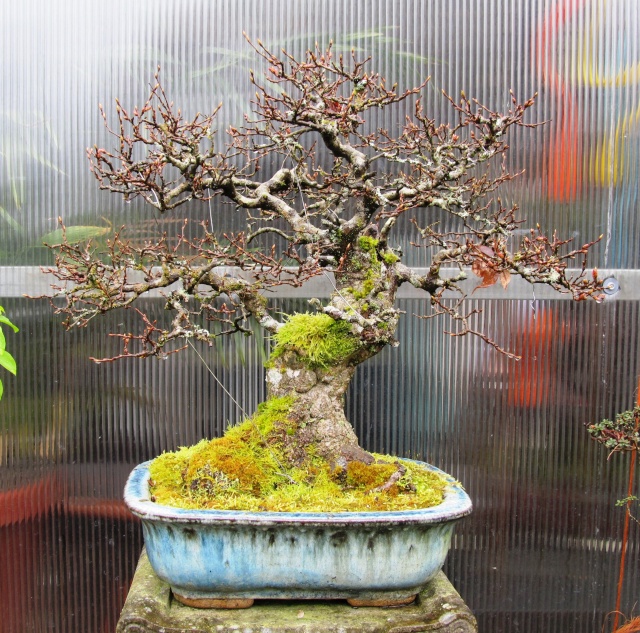
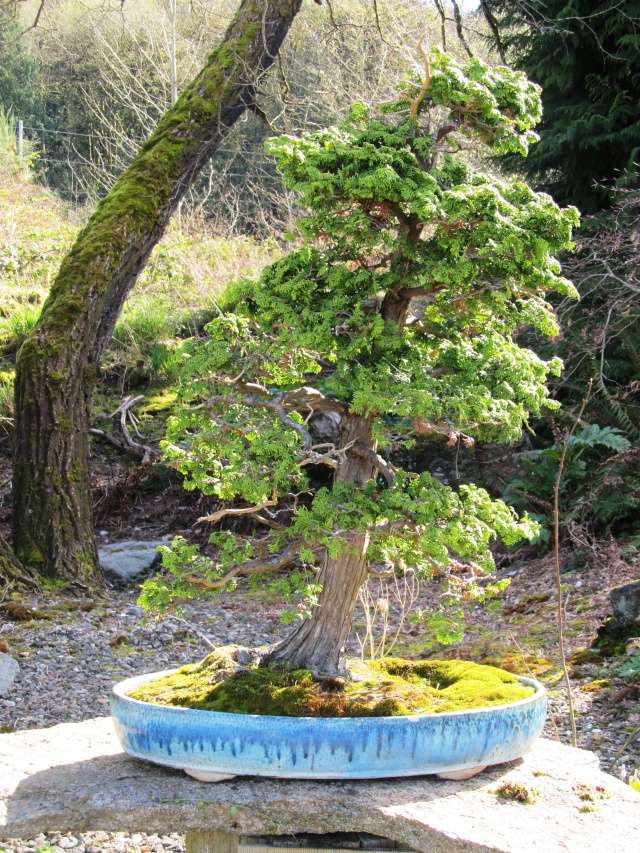
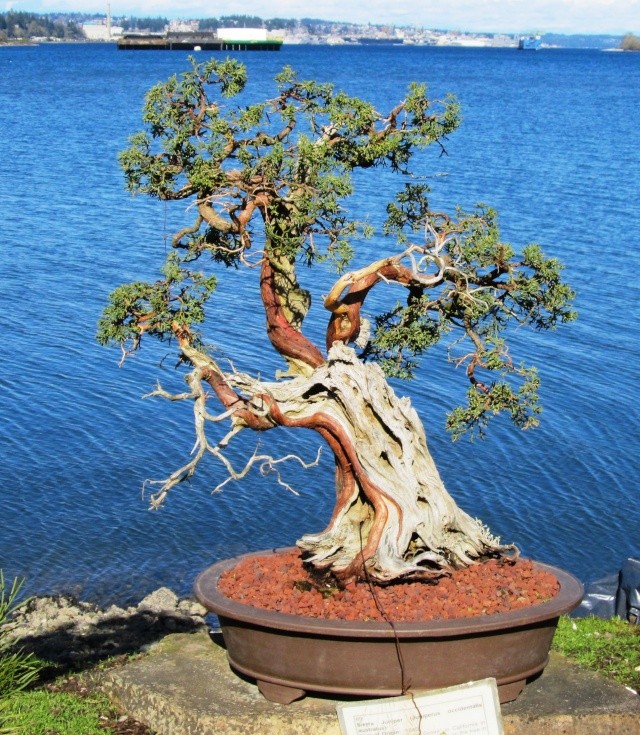
I am always on the lookout for bonsai that have something to say about the experience of trees in nature. I find them now and again too, but not so often. At Elandan Gardens all the bonsai look that way. To be sure, if you were out walking and came across a landscape-sized version of one of Dan's bonsai it would be the most amazing tree you ever saw, but still the form of the thing would be credible. His bonsai are fantastic but believable. Under the right circumstances a tree in nature actually could grow that way. This matters to me for some reason, so as I wandered around the garden that day every tree on display was a lesson to me and I was looking closely, taking mental notes. Whereas years ago I walked these same paths and marveled at what I saw as so many pieces of great old material and then mentally reworked them into the more refined and artificial shapes I had memorized from bonsai books and magazines, now I looked at them as the work of an artist and studied them to see what I could learn, to try and understand why this was done like this and that was done like that. I used the term "artist" just now and that begs for clarification. That word is often used casually as a catch-all for any person who does creative work, whether it is painting or music or bonsai or whatever. There is a higher plane of meaning for the word artist, though, and when it is applied in that sense it must be used with far greater discretion. There are few artists. Many want to be and some declare themselves to be, but there are few real artists in bonsai. Who gets to decide? I do. Well, for me I do anyway. You can decide for yourself who is and who is not, and if you want to approach it with a more-the-merrier mentality, go right ahead. I am very selective in applying that term in its higher sense of meaning and I call Dan Robinson an artist. The reason his bonsai looked so much better to me this time around probably does not have much to do with the effect of the last 14 years on his trees. The trees probably have not changed all that much. The change is in me. It has taken the last 14 years for me to finally catch on to what Dan's art is all about.
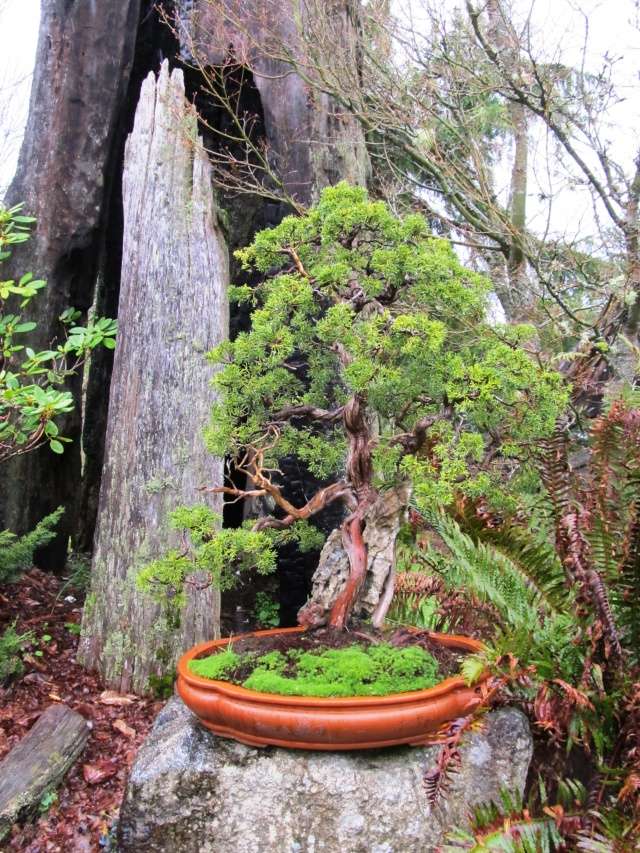

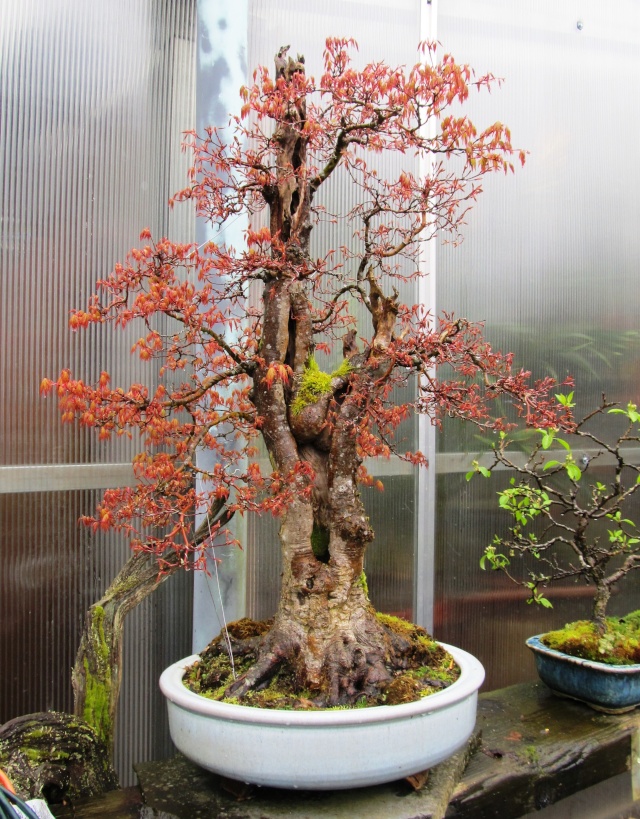
That is not to say I agree with everything he does in bonsai nor do I think Dan himself is some sort of superior human being. There is too much of the cult of personality at work in bonsai today as it is, with factions formed in defensive allegiance to this teacher and to that master or even to this one who studied with that one, and I will not contribute to it. Rather, I see Dan as a kindred spirit when it comes to understanding how bonsai can be used as an artistic vehicle for expressing an individual experience of nature. He came to that realization and created a body of work that exemplifies the approach long before I started bonsai, let alone came to understand the concept of Naturalism, which is what we are talking about. No wonder I think highly of him, he is a pioneer and I follow in his wake. He is generous with his information too, and can articulate his ideas and can show you what he means with fabulous bonsai that are the product of his own mind and his own hands. There are a number of his ideas I do not agree with and would not choose to follow, and there are things I want to do in bonsai that hold no apparent interest whatsoever to him, but this is of little matter. There are aspects of his personality I suspect would wear badly on me if I was overexposed to them, and I take it as a given that he could say the same of me, but this is of little matter either. All that matters in the end is the work he does and what that work represents and what it means in the larger context of bonsai history. Dan Robinson is important because of his work; because his work can be used as proof of the legitimacy of bonsai as an art form.
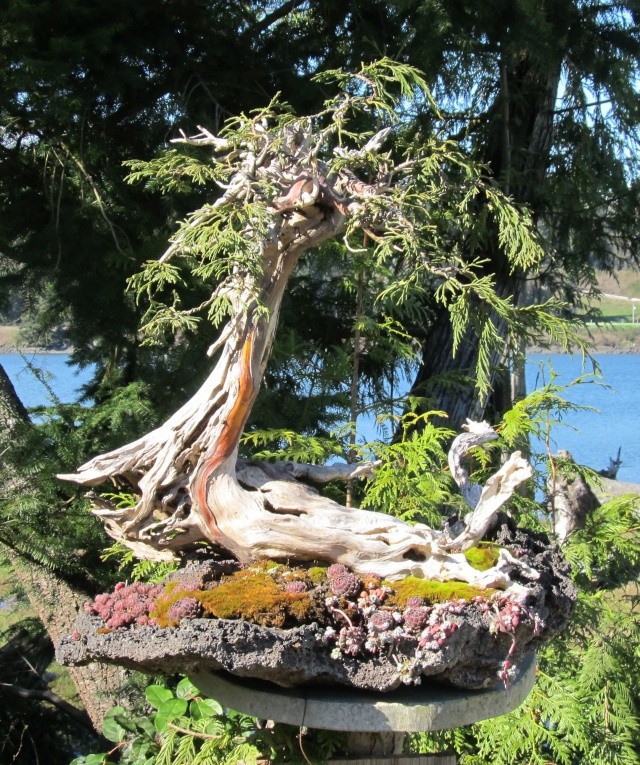




I am always on the lookout for bonsai that have something to say about the experience of trees in nature. I find them now and again too, but not so often. At Elandan Gardens all the bonsai look that way. To be sure, if you were out walking and came across a landscape-sized version of one of Dan's bonsai it would be the most amazing tree you ever saw, but still the form of the thing would be credible. His bonsai are fantastic but believable. Under the right circumstances a tree in nature actually could grow that way. This matters to me for some reason, so as I wandered around the garden that day every tree on display was a lesson to me and I was looking closely, taking mental notes. Whereas years ago I walked these same paths and marveled at what I saw as so many pieces of great old material and then mentally reworked them into the more refined and artificial shapes I had memorized from bonsai books and magazines, now I looked at them as the work of an artist and studied them to see what I could learn, to try and understand why this was done like this and that was done like that. I used the term "artist" just now and that begs for clarification. That word is often used casually as a catch-all for any person who does creative work, whether it is painting or music or bonsai or whatever. There is a higher plane of meaning for the word artist, though, and when it is applied in that sense it must be used with far greater discretion. There are few artists. Many want to be and some declare themselves to be, but there are few real artists in bonsai. Who gets to decide? I do. Well, for me I do anyway. You can decide for yourself who is and who is not, and if you want to approach it with a more-the-merrier mentality, go right ahead. I am very selective in applying that term in its higher sense of meaning and I call Dan Robinson an artist. The reason his bonsai looked so much better to me this time around probably does not have much to do with the effect of the last 14 years on his trees. The trees probably have not changed all that much. The change is in me. It has taken the last 14 years for me to finally catch on to what Dan's art is all about.



That is not to say I agree with everything he does in bonsai nor do I think Dan himself is some sort of superior human being. There is too much of the cult of personality at work in bonsai today as it is, with factions formed in defensive allegiance to this teacher and to that master or even to this one who studied with that one, and I will not contribute to it. Rather, I see Dan as a kindred spirit when it comes to understanding how bonsai can be used as an artistic vehicle for expressing an individual experience of nature. He came to that realization and created a body of work that exemplifies the approach long before I started bonsai, let alone came to understand the concept of Naturalism, which is what we are talking about. No wonder I think highly of him, he is a pioneer and I follow in his wake. He is generous with his information too, and can articulate his ideas and can show you what he means with fabulous bonsai that are the product of his own mind and his own hands. There are a number of his ideas I do not agree with and would not choose to follow, and there are things I want to do in bonsai that hold no apparent interest whatsoever to him, but this is of little matter. There are aspects of his personality I suspect would wear badly on me if I was overexposed to them, and I take it as a given that he could say the same of me, but this is of little matter either. All that matters in the end is the work he does and what that work represents and what it means in the larger context of bonsai history. Dan Robinson is important because of his work; because his work can be used as proof of the legitimacy of bonsai as an art form.



Arthur Joura- Member
 Re: American Bonsai at the NC Arboretum
Re: American Bonsai at the NC Arboretum
Thank you for this interesting story about Dan Robinson. Influential for sure and one of the pioneers of collecting North American trees. I am happy to hear he’s doing well. He certainly seems to have remained true to his particular vision. Thank you also for the photos of a collection that is nothing if not interesting.
I have to say Mr. Robinson’s story seems to be somewhat buried in a larger, overarching opinion piece. Nothing wrong with that. As a literary device it’s a well-worn path. When considered as an op-ed posted in a public forum I don’t believe it’s any breech of etiquette to respond with a viewpoint that differs from that put forth. Normally I would let it alone. I think we all have better things to do than disagree with strangers on the internet. It strikes me as odd though, the point of view offered seems rather defensive in nature and preemptively characterizes holders of viewpoints coming from other directions as unenlightened. Is there a battle raging about these issues somewhere? Some grand debate? The point of view expressed seems to be tilting at windmills that are fading fast. Stateside it appears fewer and fewer are interested in the Japanese example over the last ten years. Trunk collecting seems to be the coming thing.
It’s the use of rhetoric in the article bothers me a bit. A case could be made some of the arguments put forth are specious. You seem to have erected a straw man who “has certain ideas” “firmly fixed” “shaped by the look” “of the Japanese example” which “represents the ultimate level of bonsai excellence” (and here’s the kicker) “to which all who pursue bonsai should aspire”. Wow. You’ve built the perfect bonsai nazi. One who ”will think” Dan Robinson’s trees “need fixing up by someone who better understands what bonsai should look like, maybe by you or better yet your sensei”. Am I the only one who finds this snarky? Granted you do give us hope. Once his “thinking expands” and “reaches a point of understanding” he’ll finally get it. Or so we hope. Lofty goal indeed. There’s also some irony in that the viewpoint held up as enlightened is currently the most popular. At least in this country if the internet is any indication. Is that caused by a majority of practitioners all becoming enlightened through expanded thinking simultaneously?
When it’s stated: “there is such a gulf between the look of trees as they exist in nature and trees as they are represented in conventional bonsai” it can only be concluded this comes from an individual who’s spent little time wandering the wild places of the American west. Places where every turn reveals yet another jumbo version of ‘’conventional’’ bonsai. Places that will make one weep. Overcome by the beauty in contrast to our insignificance. By fashioning our trees are we now to be faulted if we idealize them a bit? Is it now wrong to help them appear as though they were formed by a natural force which happened to care a bit about something as frivolous as the human concept of beauty? Is that now too stuffy? If one prefers a ‘wilder look’ there’s no need to feel the pressure of overcoming convention. No need to usher in a new era of American bonsai. Penjing predates bonsai. The ‘natural look’ has existed for millennia and there is nothing wrong in that preference. Nothing wrong with using wild, free form expression(if the tree in question is better expressed through that approach). Unfortunately, when adopted as a ‘bonsai philosophy’ esthetic standards as far as what is and is not pleasing to the eye still apply so much of what passes for naturalistic bonsai is just sloppy work done on uninteresting ‘trees’. The 'no style' style. That’s the shame of it in my opinion. Are they works? Or much easier to maintain collections? Trunk collections.
It is to me puzzling that you would use Dan Robinson and his trees to illustrate your point of view. Would it not have more weight behind it, more strength to it if you showed us how this expanded thinking manifests itself in your own work? How your trees got better once you shed the yoke of stuffy formality? Sorry but I can only characterize this as a load of self righteous hooey.
I think this is the problem when we intellectualize what is essentially a visceral experience. Suddenly we find ourselves in divisive camps. It’s fine though. If you can get people to salute your flag that’s great. More power to you, the individual, but to me it is troubling that someone in your position as a curator of a large public collection can so casually disrespect the roots of it all. Disrespectful to a culture where, if the press on you is correct, you studied. Maybe you do have a better idea. I can't wait to see the results. If the goal is to have American bonsai as easily recognizable we don’t have to wait for more enlightenment. In a large part they already are. In my opinion beating the wild & natural drum isn’t helping.
Mike Iler
I have to say Mr. Robinson’s story seems to be somewhat buried in a larger, overarching opinion piece. Nothing wrong with that. As a literary device it’s a well-worn path. When considered as an op-ed posted in a public forum I don’t believe it’s any breech of etiquette to respond with a viewpoint that differs from that put forth. Normally I would let it alone. I think we all have better things to do than disagree with strangers on the internet. It strikes me as odd though, the point of view offered seems rather defensive in nature and preemptively characterizes holders of viewpoints coming from other directions as unenlightened. Is there a battle raging about these issues somewhere? Some grand debate? The point of view expressed seems to be tilting at windmills that are fading fast. Stateside it appears fewer and fewer are interested in the Japanese example over the last ten years. Trunk collecting seems to be the coming thing.
It’s the use of rhetoric in the article bothers me a bit. A case could be made some of the arguments put forth are specious. You seem to have erected a straw man who “has certain ideas” “firmly fixed” “shaped by the look” “of the Japanese example” which “represents the ultimate level of bonsai excellence” (and here’s the kicker) “to which all who pursue bonsai should aspire”. Wow. You’ve built the perfect bonsai nazi. One who ”will think” Dan Robinson’s trees “need fixing up by someone who better understands what bonsai should look like, maybe by you or better yet your sensei”. Am I the only one who finds this snarky? Granted you do give us hope. Once his “thinking expands” and “reaches a point of understanding” he’ll finally get it. Or so we hope. Lofty goal indeed. There’s also some irony in that the viewpoint held up as enlightened is currently the most popular. At least in this country if the internet is any indication. Is that caused by a majority of practitioners all becoming enlightened through expanded thinking simultaneously?
When it’s stated: “there is such a gulf between the look of trees as they exist in nature and trees as they are represented in conventional bonsai” it can only be concluded this comes from an individual who’s spent little time wandering the wild places of the American west. Places where every turn reveals yet another jumbo version of ‘’conventional’’ bonsai. Places that will make one weep. Overcome by the beauty in contrast to our insignificance. By fashioning our trees are we now to be faulted if we idealize them a bit? Is it now wrong to help them appear as though they were formed by a natural force which happened to care a bit about something as frivolous as the human concept of beauty? Is that now too stuffy? If one prefers a ‘wilder look’ there’s no need to feel the pressure of overcoming convention. No need to usher in a new era of American bonsai. Penjing predates bonsai. The ‘natural look’ has existed for millennia and there is nothing wrong in that preference. Nothing wrong with using wild, free form expression(if the tree in question is better expressed through that approach). Unfortunately, when adopted as a ‘bonsai philosophy’ esthetic standards as far as what is and is not pleasing to the eye still apply so much of what passes for naturalistic bonsai is just sloppy work done on uninteresting ‘trees’. The 'no style' style. That’s the shame of it in my opinion. Are they works? Or much easier to maintain collections? Trunk collections.
It is to me puzzling that you would use Dan Robinson and his trees to illustrate your point of view. Would it not have more weight behind it, more strength to it if you showed us how this expanded thinking manifests itself in your own work? How your trees got better once you shed the yoke of stuffy formality? Sorry but I can only characterize this as a load of self righteous hooey.
I think this is the problem when we intellectualize what is essentially a visceral experience. Suddenly we find ourselves in divisive camps. It’s fine though. If you can get people to salute your flag that’s great. More power to you, the individual, but to me it is troubling that someone in your position as a curator of a large public collection can so casually disrespect the roots of it all. Disrespectful to a culture where, if the press on you is correct, you studied. Maybe you do have a better idea. I can't wait to see the results. If the goal is to have American bonsai as easily recognizable we don’t have to wait for more enlightenment. In a large part they already are. In my opinion beating the wild & natural drum isn’t helping.
Mike Iler
Guest- Guest
 Re: American Bonsai at the NC Arboretum
Re: American Bonsai at the NC Arboretum
Interesting and well thought out reply. You made several points that I would like to comment on at some point but I will not without deeper contemplation. Suffice it to say that bonsai in America is just now starting to wake up to itself. Much of what has come from Japan is becoming boring in the face of some of the more adventurous offerings that are coming out from some of the modern artists. I too am with you and I have said it for years: I am all for the American Bonsai as long as the title and term are not used as more of a dodge to justify really bad work and crumby art.
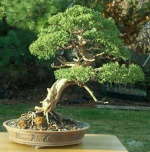
Vance Wood- Member
 Re: American Bonsai at the NC Arboretum
Re: American Bonsai at the NC Arboretum
vance... i wish i had your restraint re: contemplation prior to reply ! 
but i heartily agree with your last sentance...
mikey - i will not presume to speak for arthur as he is obviously quite good at speaking for himself but i do feel compelled to say that i think you may have over extrapolated on much of what he wrote... but again, i will leave that up to arthur's reply.
i will say though that if you are looking for arthur's work there is much of it to be found here on this forum as he is far more than just a "curator of a public collection"... he is the life of that collection, as it is maintained by only him and a couple part-time volunteers (and by "maintained" i mean every tree in that collection that has been there for any number of years bears the mark of his hand and his work)
i will also say that i do not believe arthur disrespected anyone or anything...
when i first met arthur after he did a talk here in milwaukee, i told him i considered him to be the "joe strummer" of bonsai...
now, those who only know joe strummer as the leader of the clash (as arthur, though initially bewildered, readily did having seen the clash 2x in his youth) the reference may be lost... but to know of joe strummer's entire catalog of music, life and work, the reference may seem apt... and by that i mean that joe strummer traveled everywhere, saw everything, heard everything, read everything, ABSORBED everything and took all of that and made it his own and also made it accessible to anyone who wanted some... in the clash he may have said "in 1977... no elvis, beatles or rolling stones..." but that did not mean he didnt have the utmost respect for them, and all the others that came before and built the base upon which he and others stand.
while that analogy may not perfectly fit this discussion, it is close enough to illustrate my point
(and i got lost in my typing and i'm not about to go back and delete it all...
 )
)
btw - arthur:
you and others like you, make me grateful that i came into this endeavor with open eyes and mind and no preconceived conceptions.
(no - i never did see karate kid)
(apologies for stepping into what wasn't my discussion)
but i heartily agree with your last sentance...
mikey - i will not presume to speak for arthur as he is obviously quite good at speaking for himself but i do feel compelled to say that i think you may have over extrapolated on much of what he wrote... but again, i will leave that up to arthur's reply.
i will say though that if you are looking for arthur's work there is much of it to be found here on this forum as he is far more than just a "curator of a public collection"... he is the life of that collection, as it is maintained by only him and a couple part-time volunteers (and by "maintained" i mean every tree in that collection that has been there for any number of years bears the mark of his hand and his work)
i will also say that i do not believe arthur disrespected anyone or anything...
when i first met arthur after he did a talk here in milwaukee, i told him i considered him to be the "joe strummer" of bonsai...
now, those who only know joe strummer as the leader of the clash (as arthur, though initially bewildered, readily did having seen the clash 2x in his youth) the reference may be lost... but to know of joe strummer's entire catalog of music, life and work, the reference may seem apt... and by that i mean that joe strummer traveled everywhere, saw everything, heard everything, read everything, ABSORBED everything and took all of that and made it his own and also made it accessible to anyone who wanted some... in the clash he may have said "in 1977... no elvis, beatles or rolling stones..." but that did not mean he didnt have the utmost respect for them, and all the others that came before and built the base upon which he and others stand.
while that analogy may not perfectly fit this discussion, it is close enough to illustrate my point
(and i got lost in my typing and i'm not about to go back and delete it all...
btw - arthur:
you and others like you, make me grateful that i came into this endeavor with open eyes and mind and no preconceived conceptions.
(no - i never did see karate kid)
(apologies for stepping into what wasn't my discussion)

Kevin S - Wisco Bonsai- Member
 Thoughts on Dan Robinson, part 5
Thoughts on Dan Robinson, part 5
My time in Washington was 3 days. The second day was spent driving all over the watery northwest corner of the state with Dan as my tour guide, taking in the scenery and looking for the big old trees. We headed north out of Bremerton on WA 3, then veered west on WA 104 past Squamish Harbor and the town of Shine, eventually hooking up with WA 101, the Olympic Highway, which ran alongside first Discovery Bay and then Sequim Bay, then further past Port Angeles and the Elwah Indian reservation. Suddenly strange sentinels were eyeing us with multiple heads from the side of the road - wonderful totem poles, a perfect symbol for this overcast landscape of rolling hills and big water, and no matter they were there to lure tourists into the reservation resort and casino. From there we travel on to the Salt Creek recreation area, snug along the shore of the Strait of Juan DeFuca, where we spent some time out in the chill and wind-driven rain, under the leaden sky, getting soaked while walking a beach all strewn with massive old trunks of driftwood dead trees, and we were looking out across the cold gray-green choppy water at a few rock islands jutting up in the mist looking like they drifted over from China. From there we drove south into the Olympic National Park, 2-lane touring on thickly forested roads, all closed in by a short distance panorama of lush wet dark evergreen, finally breaking out into dramatic openness as we skirted along the edge of Lake Crescent, before eventually finding our way back to the Olympic Highway and slowly back to home. We spent hour after hour talking ideas, telling lies and swapping stories. The day's trip gave me a little taste of the Pacific Northwest, which I find agreeable but would not prefer to the place I call home, and it gave me a little more insight into who Dan is and how he got that way.
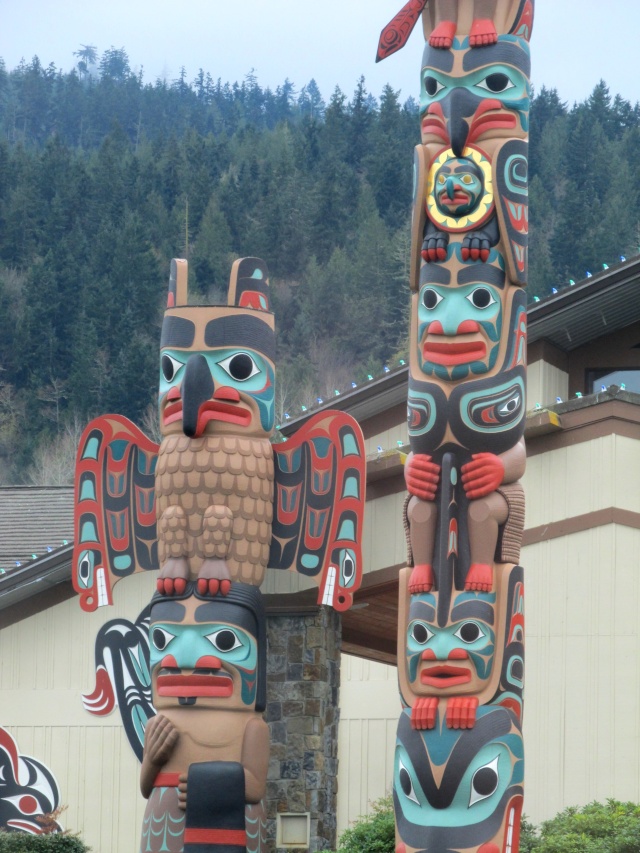

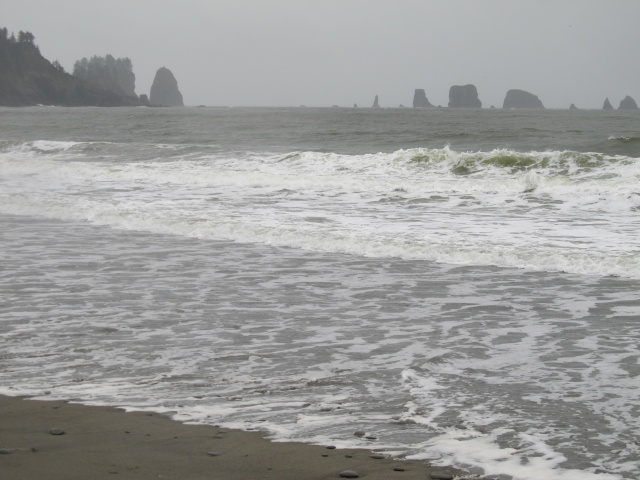
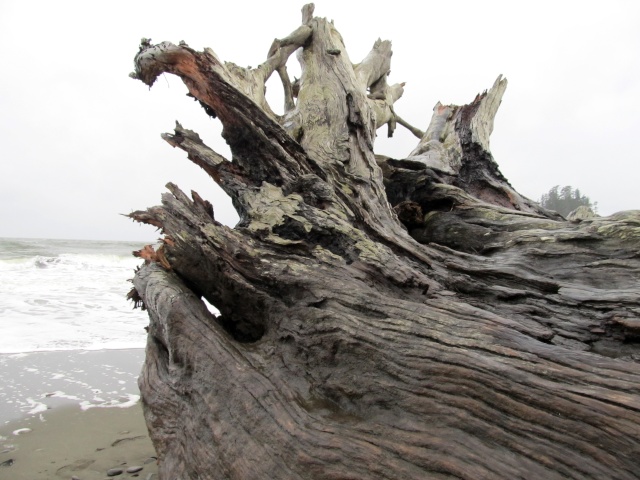

The next day the conversation continued, but this time it was at Elandan where I walked all through the garden once more, this time with Dan at my side. Yesterday we had been looking at the source material, the inspiration, the great old growth giants in the forest, and today we were looking at the bonsai that were shaped by the experience of that natural example. Shaped by a person as familiar with that natural example as he is with the feel of his own skin. He was pointing it out to me, all that experience and all that information, as we went from specimen to specimen and he was talking about where the trees came from, the wild forbidding places where they were collected or how long since he started them from seed. And he was talking about why this dead branch was still on the tree, and how the implausible looking carving on that trunk was not implausible at all, and all about the primacy of deadwood, and the importance of a focal point, and why he wants to have parts of the tree growing downward or sideways or back toward the middle, and why he has no use for a triangular shaped crown on any of his trees, or why he would not use a concave cutter or make a finish cut with a saw. And certain words kept coming back around in his conversation, bobbing up like ducks in an arcade shooting gallery, words like accretion and hydraulics and gnarly and deadwood and ancient and gnarly and cataclysmic and regeneration and gnarly, and gnarly, and gnarly. He likes his trees to be gnarly - gnarly branches, gnarly trunks, gnarly deadwood, gnarly surface roots. Gnarly with him equates with great age, with decline but also with the ongoing struggle to live, and this is what he looks for in nature, examples of this dying but surviving look. This is also what attracts him to any given subject he might work with as a bonsai. He likes best to collect wild trees from nature, trees growing in tough places that have suffered and survived and gotten old without getting big, trees that have gnarly old trunks. "Show me a great trunk!" he proclaims, the excitement from just thinking of such a thing animating him and spurring him on. If he can start with a great old gnarly trunk he can build the gnarly rest of it and make it all gnarly harmonious, make it fantastic and yet still plausible. And to walk with him through his collection, through his garden, and listen to him expound on all his experiences, thoughts, ideas, opinions, is better than any workshop you might take. And to hear him go on about all this tree stuff and the life stuff that it represents, you cannot help but be impressed by his energy, his fervor, his belief that everything he is telling you is true and important, and the amazing thing is you know he has said all this stuff, every bit of it, a thousand times before, and each time he has repeated it he has done so with every bit as much energy and conviction. And when you look at him going on this way you begin to think that in the world of bonsai he is someone far out of the ordinary, a larger than life type of figure, half human and half legend, like Davy Crockett or Casey Jones. He is a John James Audubon for the ancient trees, doing 3-dimensional painting with a die grinder. With his long white hair and sun burnished old skin he can look like a Native American, a sagamore who's eyes have squinted at ten thousand sunsets. When he is up on his soapbox railing against all that is rigid, repressed and ridiculous with the way so many people do bonsai, he can take on the bearing of a tent revival preacher, and when he is telling you his idea for how to do it better he can become a most charismatic carny barker, a salesman who has complete faith in his product because he uses it himself. He is all these things wrapped up in one colorful package. Dan Robinson is bonsai royalty. He is the King of Gnarly.
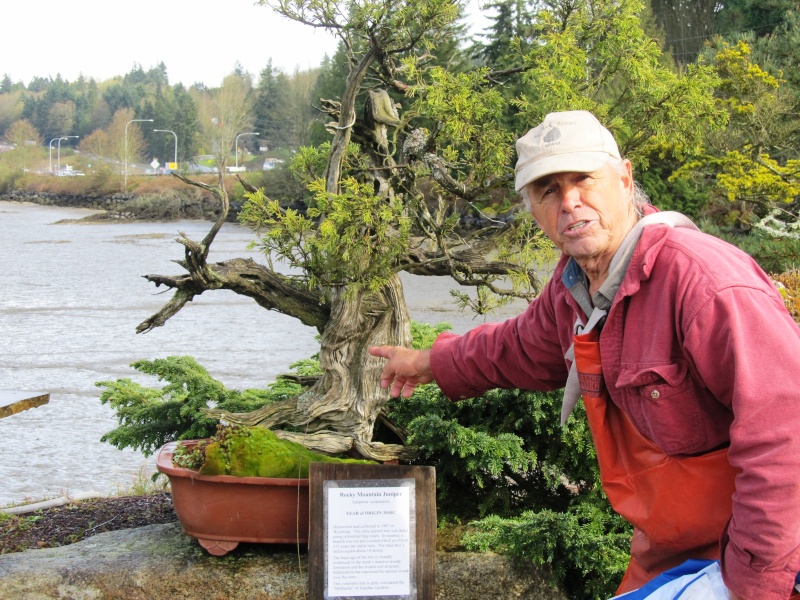
I did my program for the Puget Sound group on the night of my last day in Washington. Although the time touring around and looking at old trees and the time spent studying Dan's bonsai and the extensive running conversation with Dan was a trip in itself, I was all the time conscious of the program I was there to deliver. I was looking forward to it. I always look forward to doing a program, but this was the first time I was to deliver one on the West Coast, and the audience was comprised almost entirely of people who had never seen me before, a new audience with which to engage, innocent and unsuspecting. I did an illustrated lecture titled "Naturalism and American Bonsai", a program that has been in development for several years now, has been presented in a variety of places in different, evolving iterations. During the 3 days I had been listening to Dan I was all the while mentally comparing his take on bonsai to mine, noting the similarities and even more so the differences, and I think this was good in terms of furthering my thought process regarding both naturalism and American bonsai, crystallizing some ideas and stimulating a few insights. I felt in good form doing the presentation that night. People came up afterward and had complimentary things to say, but you can never be 100% certain how well you have communicated with an audience when you present a program. It is a pleasant feeling to have people respond well but you cannot know for certain if what they are responding to is actually what you intended by what you said. You can never know for sure who, if anyone, you truly reached. This thought sometimes discourages me but ultimately I have come to decide it does not matter so much. You cannot control it. You have an idea and you think it has some merit so you put it out there and maybe someone responds, or maybe they do not. Maybe they have no idea what you are talking about. But it is the act of putting it out there that matters, participating in the free flowing stream of ideas that gooses humankind slowly ever forward. 14 years ago I wandered into Elandan Gardens and met Dan Robinson, and he put forth a lot of ideas, some through his words and some through his work, and I really did not know what to make of it all. I would not have said at the time that his ideas reached me, but looking back now I have to think they did. At least some of them. Maybe some of the ideas I shared that night in Seattle will have a similar reverberation in the minds of others, but as I said before, you can never know for sure.





The next day the conversation continued, but this time it was at Elandan where I walked all through the garden once more, this time with Dan at my side. Yesterday we had been looking at the source material, the inspiration, the great old growth giants in the forest, and today we were looking at the bonsai that were shaped by the experience of that natural example. Shaped by a person as familiar with that natural example as he is with the feel of his own skin. He was pointing it out to me, all that experience and all that information, as we went from specimen to specimen and he was talking about where the trees came from, the wild forbidding places where they were collected or how long since he started them from seed. And he was talking about why this dead branch was still on the tree, and how the implausible looking carving on that trunk was not implausible at all, and all about the primacy of deadwood, and the importance of a focal point, and why he wants to have parts of the tree growing downward or sideways or back toward the middle, and why he has no use for a triangular shaped crown on any of his trees, or why he would not use a concave cutter or make a finish cut with a saw. And certain words kept coming back around in his conversation, bobbing up like ducks in an arcade shooting gallery, words like accretion and hydraulics and gnarly and deadwood and ancient and gnarly and cataclysmic and regeneration and gnarly, and gnarly, and gnarly. He likes his trees to be gnarly - gnarly branches, gnarly trunks, gnarly deadwood, gnarly surface roots. Gnarly with him equates with great age, with decline but also with the ongoing struggle to live, and this is what he looks for in nature, examples of this dying but surviving look. This is also what attracts him to any given subject he might work with as a bonsai. He likes best to collect wild trees from nature, trees growing in tough places that have suffered and survived and gotten old without getting big, trees that have gnarly old trunks. "Show me a great trunk!" he proclaims, the excitement from just thinking of such a thing animating him and spurring him on. If he can start with a great old gnarly trunk he can build the gnarly rest of it and make it all gnarly harmonious, make it fantastic and yet still plausible. And to walk with him through his collection, through his garden, and listen to him expound on all his experiences, thoughts, ideas, opinions, is better than any workshop you might take. And to hear him go on about all this tree stuff and the life stuff that it represents, you cannot help but be impressed by his energy, his fervor, his belief that everything he is telling you is true and important, and the amazing thing is you know he has said all this stuff, every bit of it, a thousand times before, and each time he has repeated it he has done so with every bit as much energy and conviction. And when you look at him going on this way you begin to think that in the world of bonsai he is someone far out of the ordinary, a larger than life type of figure, half human and half legend, like Davy Crockett or Casey Jones. He is a John James Audubon for the ancient trees, doing 3-dimensional painting with a die grinder. With his long white hair and sun burnished old skin he can look like a Native American, a sagamore who's eyes have squinted at ten thousand sunsets. When he is up on his soapbox railing against all that is rigid, repressed and ridiculous with the way so many people do bonsai, he can take on the bearing of a tent revival preacher, and when he is telling you his idea for how to do it better he can become a most charismatic carny barker, a salesman who has complete faith in his product because he uses it himself. He is all these things wrapped up in one colorful package. Dan Robinson is bonsai royalty. He is the King of Gnarly.

I did my program for the Puget Sound group on the night of my last day in Washington. Although the time touring around and looking at old trees and the time spent studying Dan's bonsai and the extensive running conversation with Dan was a trip in itself, I was all the time conscious of the program I was there to deliver. I was looking forward to it. I always look forward to doing a program, but this was the first time I was to deliver one on the West Coast, and the audience was comprised almost entirely of people who had never seen me before, a new audience with which to engage, innocent and unsuspecting. I did an illustrated lecture titled "Naturalism and American Bonsai", a program that has been in development for several years now, has been presented in a variety of places in different, evolving iterations. During the 3 days I had been listening to Dan I was all the while mentally comparing his take on bonsai to mine, noting the similarities and even more so the differences, and I think this was good in terms of furthering my thought process regarding both naturalism and American bonsai, crystallizing some ideas and stimulating a few insights. I felt in good form doing the presentation that night. People came up afterward and had complimentary things to say, but you can never be 100% certain how well you have communicated with an audience when you present a program. It is a pleasant feeling to have people respond well but you cannot know for certain if what they are responding to is actually what you intended by what you said. You can never know for sure who, if anyone, you truly reached. This thought sometimes discourages me but ultimately I have come to decide it does not matter so much. You cannot control it. You have an idea and you think it has some merit so you put it out there and maybe someone responds, or maybe they do not. Maybe they have no idea what you are talking about. But it is the act of putting it out there that matters, participating in the free flowing stream of ideas that gooses humankind slowly ever forward. 14 years ago I wandered into Elandan Gardens and met Dan Robinson, and he put forth a lot of ideas, some through his words and some through his work, and I really did not know what to make of it all. I would not have said at the time that his ideas reached me, but looking back now I have to think they did. At least some of them. Maybe some of the ideas I shared that night in Seattle will have a similar reverberation in the minds of others, but as I said before, you can never know for sure.

Arthur Joura- Member
 Re: American Bonsai at the NC Arboretum
Re: American Bonsai at the NC Arboretum
beautifully conveyed.
and glad to see you exhibiting your youthful exuberance on top of that incredible driftwood.
and glad to see you exhibiting your youthful exuberance on top of that incredible driftwood.

Kevin S - Wisco Bonsai- Member
 Re: American Bonsai at the NC Arboretum
Re: American Bonsai at the NC Arboretum
Whoa Arthur.
Just when I think you've pretty much hit the plateau of ideas and insight in this thread.....
Ya' havta' go and Gobsmack us all with this bit of sublime..... GNARLINESS?!!!!
Whew.... c'mon now. You have given us a lot with this one, man. I am sorely tempted to dissect.
Digress.
Analyze.
But, it seems it may serve me best to reply as Kevin did to one of my prior observations:
I mean, after all..... what can you (reasonably) say after someone has actually invoked the spirit and life of the now immortal Joe Strummer, as an analogy to support his response?
Sorry, I've got nuthin'.
But, please continue to intelligently interpret the Naturalistic Bonsai.
Tame the Wildness.
And...as Walter Pall has so eloquently described in his inimical, gentle Austrian manner,
"Making believable, Naturalistic Bonsai is hard.... it is NOT an excuse to produce crap!"
Uhhh.... yeah. We're working on this, okay? You amazing folks out there up front, that I still see patiently trying to call us up to join you - aren't dead yet! Hang in there. Give us time. Making your students actually THINK - and apply concepts - is always harder (and riskier) then having them rigidly follow formulaic principles and rules.
There's a wider audience out there for these concepts than you may think. And, not many of us have this thing down very well yet.
But, be patient.... we're working on it.
Just when I think you've pretty much hit the plateau of ideas and insight in this thread.....
Ya' havta' go and Gobsmack us all with this bit of sublime..... GNARLINESS?!!!!
Whew.... c'mon now. You have given us a lot with this one, man. I am sorely tempted to dissect.
Digress.
Analyze.
But, it seems it may serve me best to reply as Kevin did to one of my prior observations:
Kevin, aka - the 'beer city snake' wrote:What he said !
I mean, after all..... what can you (reasonably) say after someone has actually invoked the spirit and life of the now immortal Joe Strummer, as an analogy to support his response?
Sorry, I've got nuthin'.
But, please continue to intelligently interpret the Naturalistic Bonsai.
Tame the Wildness.
And...as Walter Pall has so eloquently described in his inimical, gentle Austrian manner,
"Making believable, Naturalistic Bonsai is hard.... it is NOT an excuse to produce crap!"
Uhhh.... yeah. We're working on this, okay? You amazing folks out there up front, that I still see patiently trying to call us up to join you - aren't dead yet! Hang in there. Give us time. Making your students actually THINK - and apply concepts - is always harder (and riskier) then having them rigidly follow formulaic principles and rules.
There's a wider audience out there for these concepts than you may think. And, not many of us have this thing down very well yet.
But, be patient.... we're working on it.
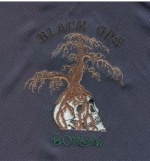
Auballagh- Member
 Re: American Bonsai at the NC Arboretum
Re: American Bonsai at the NC Arboretum
Interesting posts. Just the sort of meaty stuff I was hoping or on this forum!
Some people derive great satisfaction form going against the stream and even ruffling feathers. I think perhaps Dan Robinson is one of them. I'm all for it. There should be more of them. However, if you are setting yourself up as such a person you should (for your own advantage) be prepared to listen to the criticisms and opinions about your ideas from others. (Of course I'm not saying Dan does not. I have no idea).
Dan's ideas of naturalism is not new but I must admit he has taken them to an extreme in the bonsai field. Whether it is good or bad is always a matter of opinion and in the internet spirit of ''everyone is an expert'' I take a more middle ground view.
There are more and more grumblings about some contemporary Japanese offerings coming from the west. I believe some of them are quite justified. The most pertinent example that springs to mind are the over-refined foliage mounds of some pines and junipers set on top of tortured, twisted deadwood. It does not sit quite right with me that such a lush, even and uniform crown should sit over what is perceived to be a tree which must have suffered a traumatic existence. (Some of Kimura type trees would be an example)
Maybe ''over-refined'' is not quite accurate. Maybe they are not refined in the most sympathetic way. A lazy way of thinking ''now that I have the branches where I want them, I just need to quickly cover them in green and I'm done''? Or maybe it's just the way the Japanese aesthetic sees it. Whatever the case there is no denying that to some Western (and also I believe Japanese) eyes, something is not right.
On the other hand we have Dan and his believers. I have not seen the trees in person but from the pictures I see many trees which are dug up and placed in a pot with little work done to them. Some of the trees which have been wired are beginning to approach convention. Curious! Which is it going to be? I completely agree with his view about the first - second - third branch trap that we all fall (or have fallen) into should be avoided if at all possible. In my opinion that should not mean anything goes. To me one of the most important qualities of bonsai is serene beauty but with a natural resonance. Dramatic absolutely, but not strident. I don't want to walk about my trees and be visually jarred by their presence. I don't care how natural they may look. Not all trees in nature are beautiful - far from it. If the bizarre and grotesque is your thing, go for it! In my opinion one should not fall into the trap of copying nature just for the sake of it. In other words the ''It's natural so it must be ok'' view point. I say no, not necessarily.
That's where I believe a more central approach is more my thing. Easy? Definitely not. Probably very difficult. I certainly have not mastered it. A very subtle combination of refinement and naturalism. To be able to create an image of a beautiful or dramatic or even somber tree where every part sings the same tune yet has no evidence of man's hand is to my mind the ultimate goal. Unfortunately, purposefully refraining from working on the tree ''because it's natural'' doesn't work. In my opinion this (my) ultimate goal can only be achieved by working on the tree very deliberately and consistently over the years. More than ever. Knowing what to take and what to leave.
_________________
Mike
Some people derive great satisfaction form going against the stream and even ruffling feathers. I think perhaps Dan Robinson is one of them. I'm all for it. There should be more of them. However, if you are setting yourself up as such a person you should (for your own advantage) be prepared to listen to the criticisms and opinions about your ideas from others. (Of course I'm not saying Dan does not. I have no idea).
Dan's ideas of naturalism is not new but I must admit he has taken them to an extreme in the bonsai field. Whether it is good or bad is always a matter of opinion and in the internet spirit of ''everyone is an expert'' I take a more middle ground view.
There are more and more grumblings about some contemporary Japanese offerings coming from the west. I believe some of them are quite justified. The most pertinent example that springs to mind are the over-refined foliage mounds of some pines and junipers set on top of tortured, twisted deadwood. It does not sit quite right with me that such a lush, even and uniform crown should sit over what is perceived to be a tree which must have suffered a traumatic existence. (Some of Kimura type trees would be an example)
Maybe ''over-refined'' is not quite accurate. Maybe they are not refined in the most sympathetic way. A lazy way of thinking ''now that I have the branches where I want them, I just need to quickly cover them in green and I'm done''? Or maybe it's just the way the Japanese aesthetic sees it. Whatever the case there is no denying that to some Western (and also I believe Japanese) eyes, something is not right.
On the other hand we have Dan and his believers. I have not seen the trees in person but from the pictures I see many trees which are dug up and placed in a pot with little work done to them. Some of the trees which have been wired are beginning to approach convention. Curious! Which is it going to be? I completely agree with his view about the first - second - third branch trap that we all fall (or have fallen) into should be avoided if at all possible. In my opinion that should not mean anything goes. To me one of the most important qualities of bonsai is serene beauty but with a natural resonance. Dramatic absolutely, but not strident. I don't want to walk about my trees and be visually jarred by their presence. I don't care how natural they may look. Not all trees in nature are beautiful - far from it. If the bizarre and grotesque is your thing, go for it! In my opinion one should not fall into the trap of copying nature just for the sake of it. In other words the ''It's natural so it must be ok'' view point. I say no, not necessarily.
That's where I believe a more central approach is more my thing. Easy? Definitely not. Probably very difficult. I certainly have not mastered it. A very subtle combination of refinement and naturalism. To be able to create an image of a beautiful or dramatic or even somber tree where every part sings the same tune yet has no evidence of man's hand is to my mind the ultimate goal. Unfortunately, purposefully refraining from working on the tree ''because it's natural'' doesn't work. In my opinion this (my) ultimate goal can only be achieved by working on the tree very deliberately and consistently over the years. More than ever. Knowing what to take and what to leave.
_________________
Mike
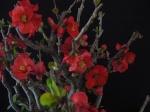
MichaelS- Member
 Re: American Bonsai at the NC Arboretum
Re: American Bonsai at the NC Arboretum
well put michael... well put.
and again i have to go with "what he said" (because it bears repeating):
yes, we are working on it.
and again i have to go with "what he said" (because it bears repeating):
Auballagh wrote: And...as Walter Pall has so eloquently described in his inimical, gentle Austrian manner,
"Making believable, Naturalistic Bonsai is hard.... it is NOT an excuse to produce crap!"
Uhhh.... yeah. We're working on this, okay? You amazing folks out there up front, that I still see patiently trying to call us up to join you - aren't dead yet! Hang in there. Give us time. Making your students actually THINK - and apply concepts - is always harder (and riskier) then having them rigidly follow formulaic principles and rules.
There's a wider audience out there for these concepts than you may think. And, not many of us have this thing down very well yet.
But, be patient.... we're working on it.
yes, we are working on it.

Kevin S - Wisco Bonsai- Member
Page 17 of 40 •  1 ... 10 ... 16, 17, 18 ... 28 ... 40
1 ... 10 ... 16, 17, 18 ... 28 ... 40 
 Similar topics
Similar topics» American Bonsai at the NC Arboretum
» WISTERIA BONSAI AT INTERNATIONAL BONSAI ARBORETUM
» Ashville arboretum bonsai
» Show the Autumncolour from your bonsai
» Trip to the Rochester Arboretum
» WISTERIA BONSAI AT INTERNATIONAL BONSAI ARBORETUM
» Ashville arboretum bonsai
» Show the Autumncolour from your bonsai
» Trip to the Rochester Arboretum
Page 17 of 40
Permissions in this forum:
You cannot reply to topics in this forum






